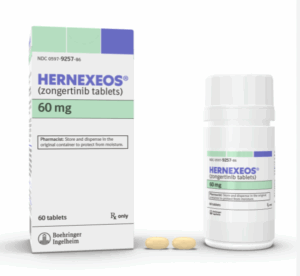Background – Glioblastoma and BRAF
BRAFV600E mutations are rarely encountered in adult glioblastoma with an incidence ranging from less than 1% to 8%. But young adults, i.e. 17 to 35 years, seem to have higher mutation rates of up to 15%.
BRAF V600E mutations should be considered for routine testing as they are part of the many factors that drive the development of many cancers.
Tafinlar is a drug which targets BRAFV600E mutations and therefore can cause the tumor to stop growing and kill its cells.
Mekinist is a cancer drug. It is a MEK inhibitor drug with anti-cancer activity. It inhibits MEK1 and MEK2 which are components in the inner part of the tumor cell that also contribute to its growth and proliferation.
The combination of these two drugs is approved for treating Melanoma patients.
And now a durable clinical benefit was seen from this combination in treating patients with BRAF V600E mutant low- and high-grade glioma, such as Glioblastoma. It was a phase 2 study by the name ” ROAR study”.
About the ROAR clinical trial
ROAR was a study of Tafinlar and Mekinist in patients with BRAF V600E mutation–positive rare cancers.
37 patients with glioma were enrolled and included in the primary analysis.
Only patients with advanced disease and no available standard treatment options were eligible for enrollment to the study.
Patients received Tafinlar 150 mg twice daily and Mekinist 2 mg once daily.
Results of the High Grade Glioma Cohort, e.g. Glioblastoma
- 24% of patients had their tumor decrease in volume
- 7% of patients had their tumors vanished from the MRI!
- The median duration of response was 36.9 months (over 3 years)
- At 2 years, 68.8% of patients were still responding to the treatment
- The median survival was 17.6 months which is more than the standard of care. Mind this is “median” – meaning 50% lived longer than 17.6 months and 50% less.
Results of the Law Grade Glioma Cohort
- 69.0% of patients had their tumor decrease in volume
- 8% of patients had their tumors vanished from the MRI!
- The median duration of response was not reached
- At 2 years, 76.2% of patients were still responding to the treatment
- The median survival was still not reached at the time of the analysis
Side Effects
The hardest side effects were fatigue (9% of patients), neutrophil count decreased (9%), headache (5%) and neutropenia (5%).
Some patients needed dose reduction and some stopped the treatment due to the side effects.
Contact us so we can help you to actually get the most advanced treatments
TRIAL•IN Pharma
Because we, do not give up on life!
Contact us 24/7 –
Call center +44.2082.426.039
More information about Glioblastoma>>








